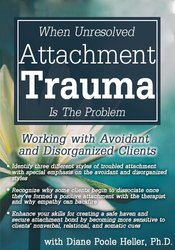

Many clients bring to therapy the remnants of attachment wounds experienced before they learned to speak, so talk therapy is often ineffective at getting to the root of early memories that can continue to roil emotions and disturb relationships. This workshop presents a unique approach to correcting insecure attachment through specific corrective experiences that address the emotional injuries they incurred in early life. Through experiential exercises and videos of client sessions, you’ll see the profound effect of DARe (Dynamic Attachment Re-Patterning Experience) work in action. You’ll focus on how to:

Diane Poole Heller, Ph.D., is an internationally-recognized speaker, author, and expert in the field of attachment theory and trauma resolution. She developed a signature series on adult attachment called DARe (Dynamic Attachment Re-patterning experience), that facilitates more fulfilling adult relationships.
In 1989, she began working with Dr. Peter Levine, teaching for 25 years for SEI.
She's authored 3 books: Crash Course, on auto accident trauma; Healing Your Attachment Wounds: How to Create Deep and Lasting Relationships; and The Power of Attachment: How to Create Deep and Lasting Intimate Relationships. Her film, "Surviving Columbine," supported community healing after the Columbine High School shootings.
Speaker Disclosures:
Financial: Dr. Diane Poole Heller receives a speaking honorarium from Trauma Solutions. She is a published author and receives royalties. She receives a speaking honorarium and recording royalties from PESI, Inc. She has no relevant financial relationships with ineligible organizations.
Non-financial: Dr. Diane Poole has no relevant non-financial relationships.
1.Therapeutic Presence
a.Advantages
b.Disadvantages
2.The Role of family in Attachment Style Development
3.Styles of Attachment
a.Secure
b.Avoidant
c.Ambivalent
d.Disorganized
4.Defining Secure Attachment
a.Tone of Voice
b.Safety
c.Protection
d.Humor
e.Relaxation
f.Self-Regulation
5.Secure Attachment Strategies
a.Repairing Mis-attunements
b.Repair Rituals
c.Secure Priming
d.Synaptic Sculpting
e.Kind Eyes Exercise
f.Affect Modulation
g.Regulating the Nervous System
h.Reversing the Freeze Response
i.Somatic Strategies (D.A.R.e.)
6.Neuroscience & Neuroplasticity
a.The science of what helps us connect
b.The Fluidity of Memory
c.Impact of Abuse on the brain
7.Being sensitive to client cues
a.Nonverbal cues
b.Relational cues
c.Somatic cues
8.Sadistic Abuse
9.Trauma Resolution
10.Video Vignettes of Complex Trauma Treatment
Please wait ...